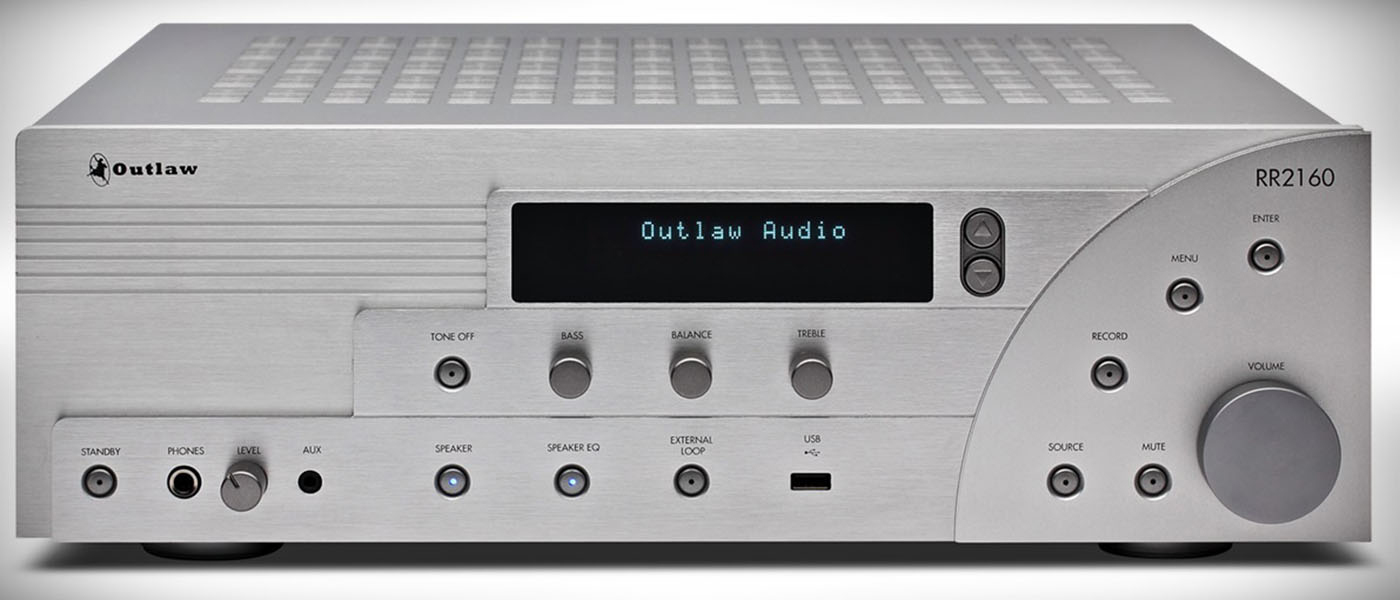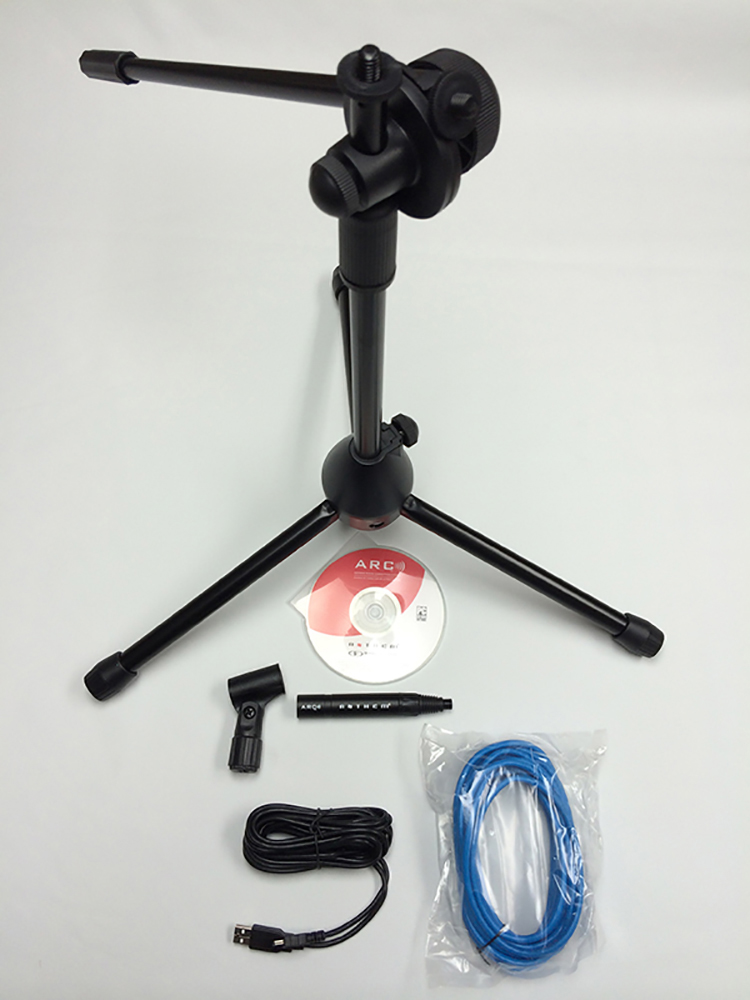This handsome looking piece of gear supports Dolby Atmos decoding out of the box and will support DTS:X decoding, by years’ end, with a future firmware update that can be user installed. The MRX 1120 comes equipped with 11 channels of amplification on board, with the main five channels rated at 140 watts into 8 ohms and the remaining six channels rated at 60 watts into 8 ohms. Also included in the package is the latest version of Anthem’s acclaimed ARC 2 room correction system, and DTS Play-Fi which supports streaming services like Spotify, Pandora etc.
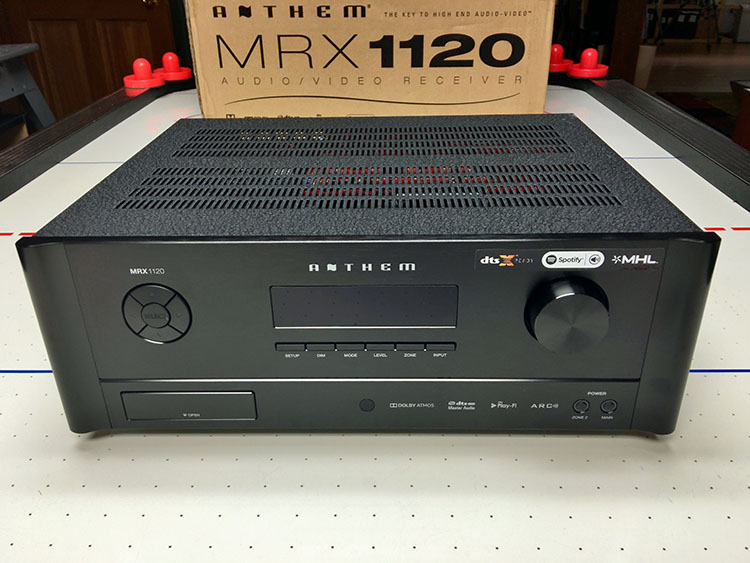
Anthem MRX 1120 A/V Receiver
- Excellent design and build quality.
- 11 channels of amplification.
- Amplifier channels handle 4 ohm speakers with ease.
- ARC 2 room correction produced an exceptional level of quality sound.
- 6 HDMI 2.0a inputs supporting HDCP 2.2 and 4K video.
- No analog video inputs.
Earlier this year, at CES 2016, the fine folks at Anthem Electronics revealed their updated MRX receiver line. These new units featured Dolby Atmos and would be upgradable to DTS:X capability via a firmware download later on in the year. Having had an enjoyable experience when I reviewed their entry level MRX 310 two years ago, which has now dropped from the line, I asked if I might take the top-dog MRX 1120 out for a walk this time around. About two months ago, they kindly obliged, and with four new overhead height speakers just recently installed in my home theater, the timing was perfect.
Design:
11.2 channel home theater receiver
DACS:
AKM AK4458 (D/A), AKM AK5358 (A/D)
DSP:
32 bit, quad core processor
Surround Codecs and Listening Modes:
Dolby Atmos, Dolby TrueHD, Dolby Surround, DTS:X (via future firmware update), DTS-HD Master Audio, DTS Neo: 6, Anthem Logic, All Channel Stereo
Rated Power Output:
5 x 140 watts continuous – Two channels driven @ 1% THD into 8 ohms; 6 x 60 watts continuous – Two channels driven @ 1% THD into 8 ohms
Number of Zones:
2
Room Correction:
Anthem Room Correction (ARC 2)
Amplifier Type:
Class A/B (5 main channels), Class D (6 rear and height channels)
Inputs:
HDMI (6 rear HDMI 2.0a, 1- rear HDMI 1.4 with MHL support, 1 front HDMI 1.4 with MHL support), SPDIF Coax (2), Toslink (3), RCA Analog (5 Stereo Pairs), USB (1 rear, 1 front for service and updates), RS232 (1)
Outputs:
HDMI (2 HDMI 2.0a, one has Audio Return support), Toslink (1), RCA Analog (11 channel pre-outs, 2 subwoofer outputs, 1 stereo pair for Zone 1, 1 stereo pair for Zone 2), Speaker terminals (11 pair, all powered)
Tuner:
FM
Accessories:
Remote control, calibrated microphone, mic stand, Software installation disc, USB cable, Ethernet cable, Wi-Fi antennas
Dimensions:
6.5″ H x 17.25″ W x 14.75″ D
Weight:
32 pounds
MSRP:
$3499.00 USA
Company:
SECRETS Tags:
Anthem, MRX, Receivers, ARC, Dolby Atmos, DTS:X, Home Theater, Receiver Reviews 2016
Having heard a number of Dolby Atmos demos at various audio shows, this would be my first experiment with the new surround format in my own house and I was looking forward to getting a taste of Anthem’s implementation. With a full 11 channels of onboard amplification and a price tag north of $3000.00, this is not a component for a casual installation or an entry level home theater. If history is any guide, the expectation of the MRX 1120 is for top quality performance and an exceptional level of sound quality. Let’s see if the Anthem measures up!
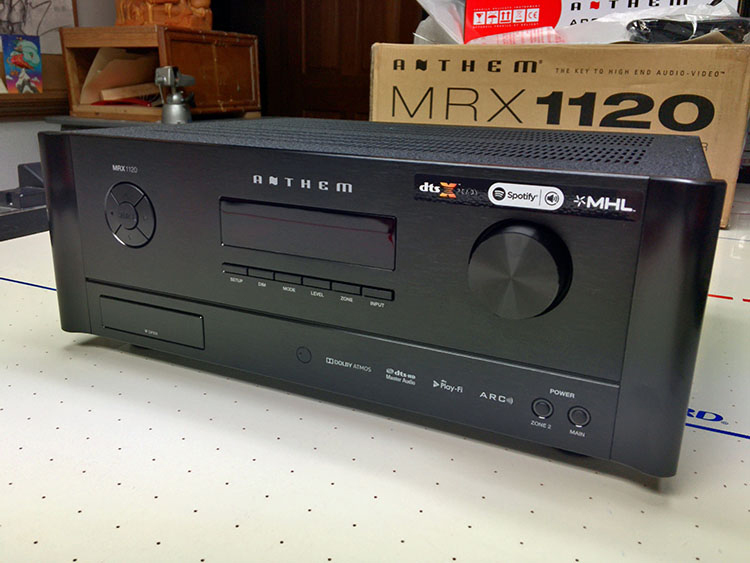
With the unpacking the MRX 1120 two things became immediately clear. Firstly, the unit itself was identical in size to the 5.1 channel MRX 310 that I reviewed two years ago. “So where did they stuff the six extra amp channels?” I thought to myself. Secondly, I became aware that the unit was noticeably heavier than the MRX 310 was, which gave a hint of an answer to my initial query.
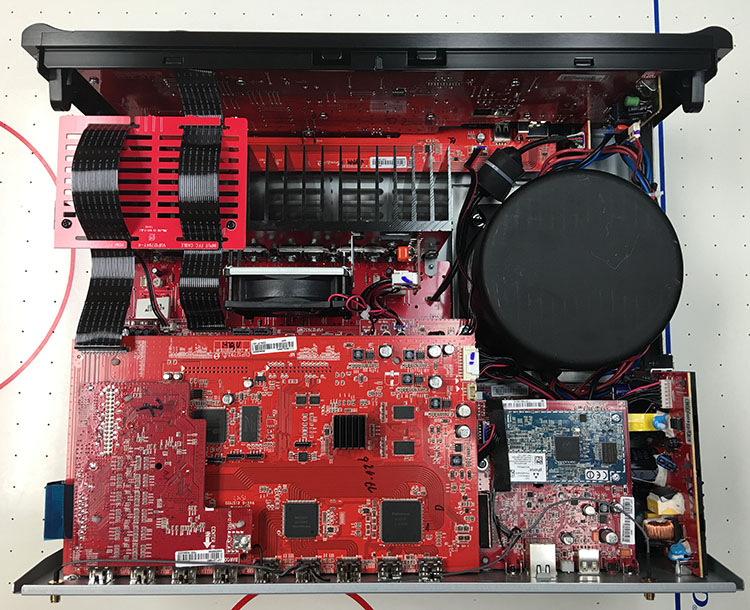
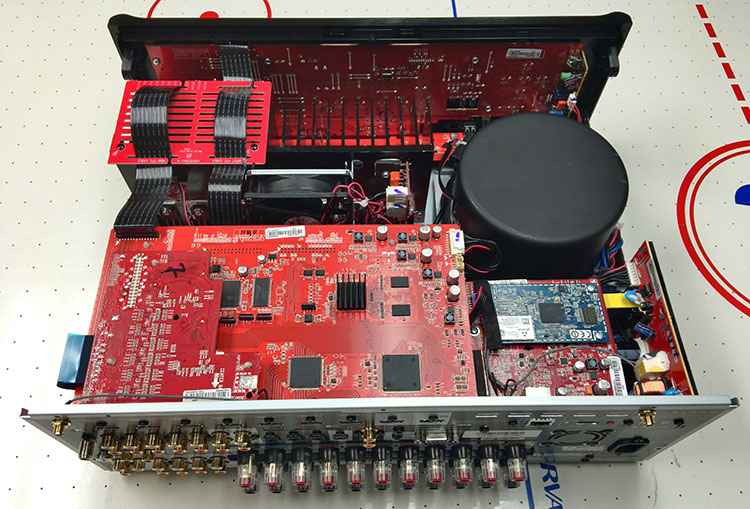
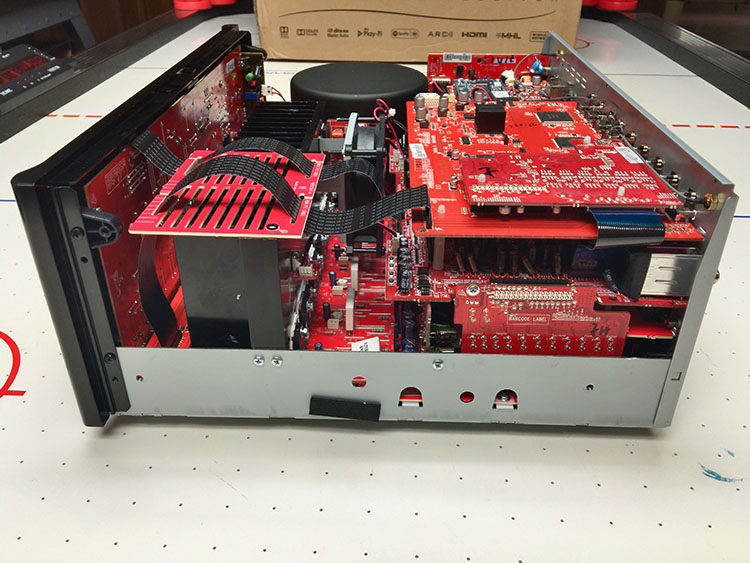
Upon removing the top cover of the receiver for a look inside, I discovered a beefy new toroidal transformer and more robust heatsinking. These are substantial upgrades over what the MRX 310 had for its amplifier section. Delving into more detail, I discovered that while the 5 main channels of the MRX 1120 are Class AB amplifiers (rated at 140 watts per channel), the rear surround and height channels are more efficient, and smaller sized, Class D amplifiers (rated at 60 watts per channel). This is a rather elegant design solution for the power section that keeps the MRX 1120 from growing out of control, dimensionally.
While on the subject of the guts of the unit, the DAC chips have been upgraded to AKM AK4458 parts which Anthem bill as “Premium 768 kHz / 32-Bit Differential-Output D/A Converters.” All digital inputs can now accept up to a 24 bit/192 kHz input signal, however a direct DSD bit-stream cannot be accepted. Convert those to PCM at your player outputs first and then you’ll be fine. The main DSP silicon is now a 32bit-Quad-Core chip which allows even better filter resolution with the ARC 2 room correction system.
The face of the MRX 1120 is essentially a carbon copy of the 310. It’s visually uncluttered with a modest array of six primary buttons under the main display labelled: Setup, Dim, Mode, Level, Zone and Input. To the left is a circular grouping of five buttons similar to a cursor scroll and select control on a remote. Below that, there is a small door covering the headphone jack, front USB (for updates) and front HDMI (1.4) inputs. The main volume knob is to the right with two small buttons for Zone 2 and Main power just below it.
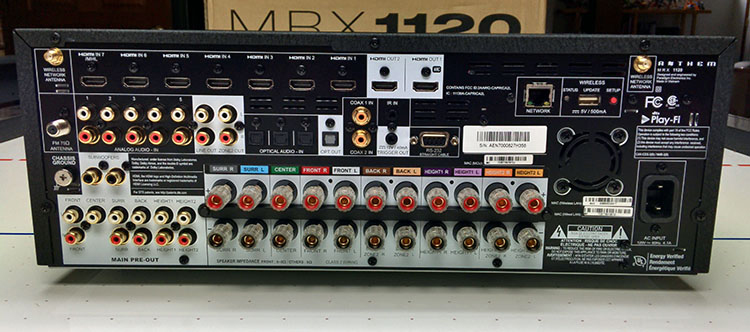
The rear panel is equally organized and well laid out with inputs and outputs in black and white color coded groups for easy identification. The MRX 1120 receiver sports eight HDMI inputs (seven in back, one in front) and two HDMI outputs. Six of the rear inputs are of the HDMI 2.0a variety which are HDCP 2.2 compliant. This means the receiver fully supports and switches 4K/60 video resolution, HDR (High Dynamic Range) video and the BT.2020 Color Gamut. The remaining rear HDMI input is HDMI 1.4 and supports MHL (Mobile High-Definition Link) as does the input in front. MHL provides special considerations for the connection of mobile devices and also allows a device to be charged when connected. One of the two HDMI outputs supports an Audio Return Channel (ARC), which allows you to listen to audio from your television without the need for an additional cable. On the MRX 1120, legacy video inputs are just that, a legacy. They don’t exist at all on this receiver period, end of story. The MRX 1120 supports five sets of stereo analog RCA inputs and five digital audio inputs (2 coaxial and 3 optical). There is also a USB connector to assist with Play-Fi updates, if a network connection is unavailable, and an Ethernet connector to be jacked into the home network, the old-fashioned way. The new-fashioned way of interfacing with your home network sees this newest Anthem sporting a pair of Wi-Fi antennas. This also allows the use of the streaming services on the 1120 and permits the ARC room correction system to be a fully wireless exercise to setup and implement.
The ARC kit, which is included with the receiver, comes with a calibrated microphone, an adjustable tripod, a USB cable, a software disc and an Ethernet cable. The software itself is simply called ARC 2 (Anthem Room Correction) and it is their latest generation of code. It features both an automatic and fully manual mode which can allow either a streamlined or a detailed level of adjustability for the system. Anthem also includes a complete set of 11.2 channel pre-outs should you want to use the MRX 1120 with higher power amplification down the road. Zone 2 audio duties can be handled with either the line level outputs or by configuring the speaker outputs through the setup menu. New on the MRX 1120 are the afore mentioned streaming services afforded through DTS Play-Fi.
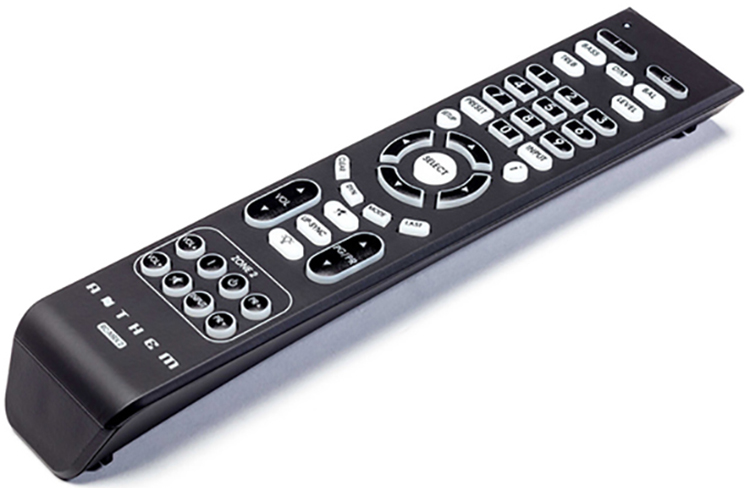
Play-Fi compatibility may be of increasing interest as there are a number of DTS Play-Fi certified network speakers coming to market and any of them could be mated to this receiver to create a whole house wireless music system with the MRX 1120 as its hub. There is also a DTS Play-Fi app for iOS, Android and Windows systems that can integrate and control the whole shooting match, along with connecting to external music servers. The remaining connections on the MRX 1120 back panel allow for antenna connection to the standard FM tuner. No AM, sorry talk radio fans, just stream it! There is also an IR input as well as an RS-232 jack that can be used to control the MRX 1120 with an external control system. A 12 Volt DC Trigger is also included which allows you to turn on another device, such as an external amplifier for zone two.
The MRX 1120 comes with the same basic, non-learning remote that the MRX 310 had. It’s light, it works and it’s backlit. Enough said.
As I found with the MRX 310, the setup of this receiver is pretty straightforward with no real surprises. The Ethernet cable connection was ditched this time around in favor of having the MRX 1120 talk to my network wirelessly. Within a few moments, that was taken care of.
Compared to some of the fancy GUI menus on many receivers and processors today, Anthem’s menu system is simple, clean and straightforward. No gee-whiz graphics here, just a simple intuitive list system. As I began to go about assigning my inputs, I discovered that five inputs are setup by default at the factory but that you can add, remove and reconfigure any inputs for a maximum of 30. A nice bonus was that HDMI sources could be reused across any input. Once the inputs were set up, I entered the distance between my primary listening position and each speaker in my room. Distances are entered in the "Listener Position" menu and can be entered in feet or meters in increments of 1 foot or .3 meters respectively. This is something that you must do manually as the Anthem Room Correction system does not do this for you when calibrating as some other systems do.
Now it was time to run the ARC 2 software. A quick check of the receiver menu showed that it had the latest firmware installed. A quick check on Anthem’s website showed there was a newer version of the software for the laptop than what came packaged with the kit. I downloaded and installed the newer software which included the calibration files that matched my microphone’s unique serial number. Anthem informed me that they are phasing out including the physical software disk with ARC in favor of just downloading the software directly when you get your unit home. That way you are always guaranteed to be working with the latest software revision. A quick note, since I use two subwoofers in my HT, Anthem advises you to level match them first with a SPL meter from the main listening position to just under 75dB each before running ARC 2, which I did.
I started the software in the Automatic Mode which found the MRX 1120 on the network and began by offering me the default choice of 5 measurement positions for the microphone. I elected to choose 6 for my room, but you can choose more if you need. Once the measurements were done and uploaded to the receiver, I reviewed the calculated settings on my laptop. While everything seemed reasonable and would have been fine to go as is, I saw that ARC 2 had set the crossover on my center channel at 100 Hz and 170 Hz on my height speakers. Through past experience, I know that those speakers can be crossed a little lower and the raw measurement graphs confirmed that there was some response to spare.
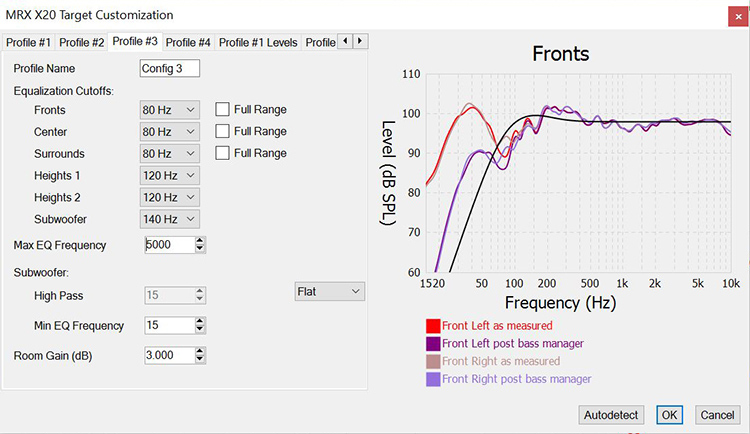
I closed up the ARC 2 Auto Mode portion of the software and opened up the Manual Mode. I selected the file which contained my measurements and pressed the Target button. This opened up a new window with a number of customization options including individual crossover settings, adjustable high-pass filtering for the subwoofers, room gain level, speaker level trims, etc. There is also provision to store and upload settings for up to 4 different speaker profiles and associate them with specific inputs if you so choose. I decided to adjust the crossover setting for my center channel to 80 Hz and the height channels to 120 Hz. After that, I pressed the Recalculate button and ARC began to re-calculate and calibrate for the new settings based off the original measurement data. When complete, press Upload and the new data is sent to the receiver. Now, it’s time for the fun stuff!
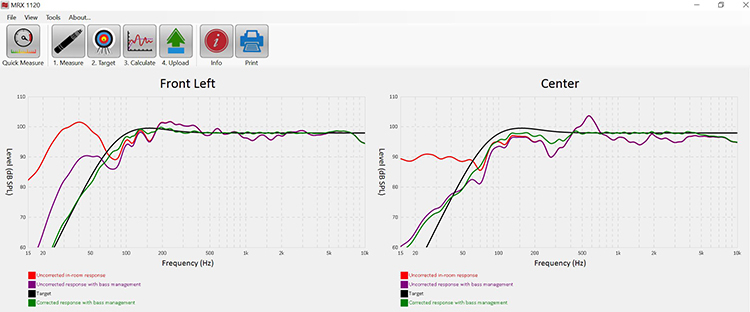




For this review, the connected components consisted of: Pioneer KURO 50” Plasma TV, OPPO BD-103 Blu-ray Player, Sony PS3, Xbox ONE, Motorola DCH-6200 Cable Decoder box, APC H-15 Power Conditioner and Blue Jeans Cable speaker wire and interconnects. Speakers used were the Salk Songtowers for the front left and right channels, a Zaph ZD3C center channel speaker, AV123 RS300 quasi-dipole surround speakers, 4 GoldenEar SuperSat 3 speakers for the height channels and Chase Home Theater 18.1 and 18.2 subwoofers.
Usually when I set up an HT receiver for review, I don’t program our universal remote so there is always a short learning curve before the receiver’s usage becomes second nature. This not only applies to me but also to my two boys who will have no barriers placed between them and the enjoyment of their video games! Having just finished setting up the MRX 1120 in an afternoon and after confirming that everything worked, I powered it off and proceeded to do some business in my studio. My 12-year-old son comes downstairs with his buddy to play Xbox and before I can pause what I’m doing to explain some pointers about the receiver to him, he has everything powered up, inputs properly selected and is up and running! I walk in, asking him how he figured it out so fast? “Easy!” he says, and then proceeds to show me how he did it, using the buttons on the unit, in a matter of seconds. It just goes to show that, once the initial set up is done, the MRX 1120 (and by extension all the Anthem MRX receivers) are basically a cinch to use and live with.
I don’t currently have any 4K source material so I can’t test if any signals of that resolution passed the 1120 successfully, but all 1080p Blu-ray content looked subjectively spotless. Colors seemed clean and true and I did not experience any HDMI handshake issues throughout any of my usage.
On the audio side of things, the Anthem was, quite simply, exemplary. My home theater sounded at least as good as I’ve ever heard it, if honestly not a touch better. My front three speakers have a 4-ohm impedance and the surrounds are 6 ohms. Neither of which presented any sort of challenge to the Anthem’s amplifier stages. In fact, the receiver kept a tight rein on all the speakers as none of them showed any signs of stress or misbehavior. Another note about the amplifiers is that when there were pauses in the music, or very quiet passages, there wasn’t a hint of any background noise even when turned up fairly loud. I’ve owned a couple of receivers where I would hear switching noise when changing inputs or there would be the slightest hiss in the background when nothing was playing. Complete silence with the MRX 1120, dead quiet, an electronic monastery.
This was also my second experience using the ARC 2 room correction system and I continue to be impressed by what it was able to accomplish in my room. The consistency of the sound, particularly the bass, across all four of my theater chairs was excellent with minimal variation. The subs were equalized just right for my liking. Bass sounded deep and punchy without getting bloated at all. Sometimes, with other EQ systems, the bass will get flattened out too much for my taste and then I invariably have to go into the settings and tweak levels and whatnot. ARC got the bass right where I wanted it on the first go. No additional “juicing’ of the levels was required. Another nice quality about the ARC system is that, since it doesn’t EQ anything above 5000 Hz, I felt that the sonic attributes that I like about my main speakers weren’t overly messed with, which has to do with why I bought them in the first place.
As this was also my first dipping-of-the-toe in the waters of Dolby Atmos, I had a little trepidation as my speaker setup was not exactly “textbook.” I couldn’t install ceiling speakers due to existing can-lighting being right where those speakers would normally go, and those Atmos-enabled “bounce” speakers weren’t an option for me either. After some research, I got 4 GoldenEar SuperSat 3 speakers and attached them to omni-mounts right at the point where the ceiling met the walls. This allowed me to angle the speakers towards the seating position so that their sound would be coming from roughly the Dolby prescribed angles. My surround speakers were also not direct radiators placed at ear level, but quasi-dipoles (only tweeters out of phase) placed just above head level. I couldn’t alter that arrangement because, at ear level, the speakers would be too close to anyone sitting at the end seats in my room. I was honestly wondering if this set up would even work. And, I had pared down from a 7.2 set up years ago because I found that 5.2 sounded so much cleaner in my room. Would adding 4 more speakers just mess things up again?
Well, after living with it for a couple of months, I can honestly say that Atmos, in general, and the Dolby up-mixer that extends non-Atmos material into the height channels is a very welcome addition that sounds better than my standard 5.2 and my original 7.2 setup, with a couple of minor caveats. Speaking generally, I found that most of the Atmos material I listened to made good use of the height channels (obviously some more than others) and that this new height layer of sound tended not to adversely draw too much attention to itself but successfully added to the overall experience. On non-Atmos encoded surround material, the Dolby up-mixer in the MRX 1120 did an admirable job of extending the soundtrack into the height channels and creating a larger sense of space without it sounding gimmicky. After switching back and forth, I found myself listening through the up-mixer for most of my surround movies and music. On some surround music recordings however, I did find that I preferred Anthem’s home-brewed “Anthem-Logic Music” steering mode better in certain instances. On 2 channel music, I will have to agree with what I’ve read from some of my other colleagues here at Secrets. The Dolby up-mixer does a noticeably less convincing job of expanding 2 channel music to multiple speakers than the old Dolby Pro Logic IIx steering did. In almost all but a precious few cases that I tried, stereo music sources just sounded thin and detached when put through the up-mixer and the height channels. In many instances with my usual receiver, Dolby Pro Logic IIx would give some surprisingly pleasing results with stereo music, particularly live recorded material. Some music examples, while not equaling truly discreet surround mixes, were actually downright impressive. The comparable DTS listening modes have never sounded as successful to IIx in my experience. The lack of an equivalent to Pro Logic IIx is not a deal breaker by any stretch on the Anthem but, speaking broadly, I wish Atmos receivers would come to market with IIx still as a listening option. Just because you may have 11 channels on tap, doesn’t mean you should always use all of them. With the ability to have ARC calibrations for up to 4 different speaker profiles, the MRX 1120 would be a perfect vehicle to have a speaker preset for expanded 2 channel music. With that being said, some of the more standout listening experiences that I had with the MRX 1120 were:

Batman vs Superman-The Ultimate Edition, Warner Bros. I’ve been a comic book fan for a good portion of my life and, as such, these particular characters hold a certain hallowed place in my heart. So let me say up front that, conceptually, this film is an absurdly long, ponderous, steaming hot load of poo! I really dislike this dark, overly serious tack that DC comics and Warner Brothers has taken with the production of their comic book properties. With overly cynical, dystopian worlds and flawed heroes that are constantly questioning themselves with overwrought internal struggles.
The main premise of this movie was adapted from parts of Frank Miller’s “The Dark Night Returns” comic book series and then taken in a direction that the comic book never intended. Even my 14-year-old son, whose alley this should be right up, kept looking at me after various scenes and said, “Dad, that was ridiculous!” I mean the best part of this film was when Wonder Woman makes her appearance in the final battle with Doomsday. Her character outshines the two leads with a bit part! Hate on this movie much? You bet I do. It’s a pig. But the Dolby Atmos soundtrack and the playback through the Anthem receiver? Oh my word, it is fantastic! Despite its story flaws, this movie has one of the better Atmos soundtracks that I have come across and the MRX 1120 plays it for all its worth. Compared with what I am used to hearing with my 5.2 setup, the new height channels really gave an extra sense of spaciousness throughout the entire movie with additional ambience and music cues applied judiciously. The heights are put to very aggressive use during the final battle with debris from crumbling buildings, helicopter fly-bys, explosions, and the like. All the height effects seemed to pan seamlessly when they needed to and really added to the sense of space without drawing undo attention away from the main action. The Anthem’s ARC 2 system also had excellent control of the low frequency effects content in this movie. The deep rumble of that Batplane when it hovered was just cavernous and palpable. Whenever Doomsday would set off one of his epic blasts, the bass hit was low, powerful and solid without ever getting muddy. Everything, as a whole, sounded crystal clear and in proper balance via the Anthem. So, in this case, the MRX 1120 made the best out of the situation by putting lipstick on a pig and successfully taking it to the ball. Not a bad party trick!

Mission: Impossible – Rogue Nation, Paramount. With this next installment in the venerable franchise, Paramount ups the ante with a really enjoyable story and an excellent Dolby Atmos soundtrack. The addition of the height channels really goes a long way here to create a true bubble of sound. Every chase scene felt bigger in dimension. The assassination attempt at the opera house had just a larger degree of space, what with the audience, backstage rigging and various effects all taking place overhead.
The extended underwater scene when Ethan Hunt is trying to facilitate Simon Pegg’s character breaking into the vault, while holding his breath was particularly immersive with plenty of panning sound, both at ear level and above. ARC 2 shined again here with plenty of controlled, hard-hitting bass throughout the film.
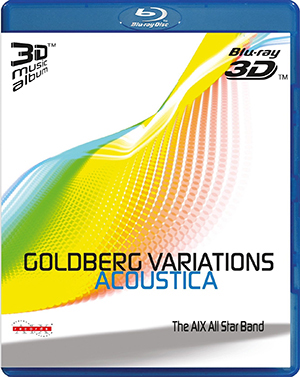
Goldberg Variations Acoustica, The AIX All Star Band, AIX Records. Another fine recording from Mark Waldrep’s label. This Blu-ray disc features 6 well regarded studio musicians re-interpreting J.S. Bach’s work through almost a jam session type of arrangement. The audio was recorded and mixed in 5.1 Dolby TrueHD at 24/96. The surround mix sounded incredibly natural on this disc with every performer properly placed in space.
The instruments had a clarity and purity to their sound that I don’t come across very often on recorded material. An “unmolested” sound would be a good way to describe it. The acoustic bass plucks came across forceful and clean sounding while both the acoustic piano and Hammond B-3 organ had an almost “right there” quality to their notes. Drums also had excellent weight and impact while the cymbals sounded as clean as a whistle. And the quiet passages that I touched on earlier? They were here and they sounded dead silent on this recording. You could tell that the musicians were genuinely enjoying playing off one another as the interplay was incredibly skillful. In particular it was great to see and hear Dean Parks and Laurence Juber trade licks on electric and acoustic guitars respectively. When switching between the standard TrueHD steering and the Dolby up-mixer, it seemed that the latter was intelligently extending the sound field higher and expanding the natural environment but still maintaining a level of clarity and cohesion. The added sound level didn’t draw undue attention to itself and sounded as if it belonged. The MRX 1120 basically put me right in the middle of the performance and it felt like I was very much there.

The Girl in the Other Room, Diana Krall, Verve Records, Multi-channel SACD. Yes, it’s the recording that is both the mainstay and the bane of everyone’s existence that goes to an audio show. It is one of the most commonly used pieces of demo material for a reason, because it sounds so darn good! I had never heard the multi-channel mix before and, frankly I hadn’t thought about it as the stereo mix is excellent by any measure. Not to engage in hyperbole but, what a fool I am! This surround mix, rendered on the Anthem using the Dolby up-mixer sounded nothing short of gorgeous!
The MRX 1120, again, put me right there in the recording studio. The instruments and the ambience of the recording were so rich though, that it could have just as easily been a nightclub. From the opening notes of “Stop This World”, the Anthem and the ARC system work convincingly as they reproduce the piano’s deep, resonant, lush sound while the kick drum had nice, impactful hits that were clearly felt. Krall’s voice is placed perfectly in the soundscape, sounding clear but with just the right amount of the trademark huskiness to its tone. The basslines through this entire disc are just palpably good, sounding big and rich but not sloppy at all. Once again, thank you ARC! On “Temptation”, probably the most overplayed audio show demo tune, the surround mix has a depth that puts the stereo mix completely to shame. Again, when switching in the Dolby up-mixer, the sound bubble just got bigger but not in an un-natural or distracting way. The MRX 1120 kept everything sound big and lush, but while maintaining control with detail and specificity to all the instruments and vocals. It could have easily fallen to sonic mush on a lesser receiver, but not with the Anthem.
Are there any negatives about the MRX 1120, since I have essentially been gushing about it up until now? Mostly small things. The remote control, while serviceable, could be so much more. I’m sure many prospective buyers would expect a learning unit be included at this receiver’s price point. During ARC setup, it would be great if, when running dual subwoofers, the software would ping them individually and allow a user to dial in their sound levels during the pre-measurement phase. The latest iteration of Audyssey does this and it is very convenient.
There are no analog 7.1 audio inputs. Some people might find this problematic depending on their setups, I didn’t.
Benchmark audio tests were conducted on both the analog inputs of the MRX 1120 and the digital input via HDMI. The source device for both analog and HDMI tests was an Oppo BDP-83SE. For the analog tests, the input level was 2.2 VRMS into the RCA inputs of the MRX 1120. The volume was adjusted for 2 VRMS at the speaker outputs.
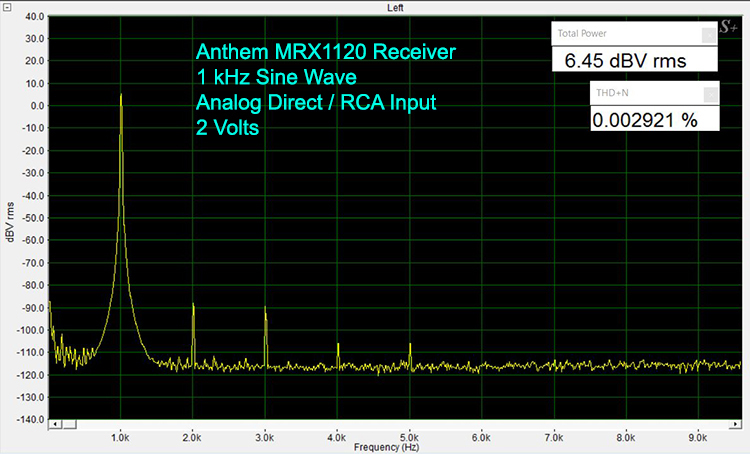
At 1 kHz into the RCA input, THD+N was 0.002921%. We see a few harmonics throughout the spectrum with the second harmonic at 2 kHz being about 88 dB below 2 VRMS.

The IMD measurement using the RCA input was 0.004248%. We see minor noise spurs on either side of the fundamentals and a second harmonic at 14 kHz at 100 dB below 2 VRMS.
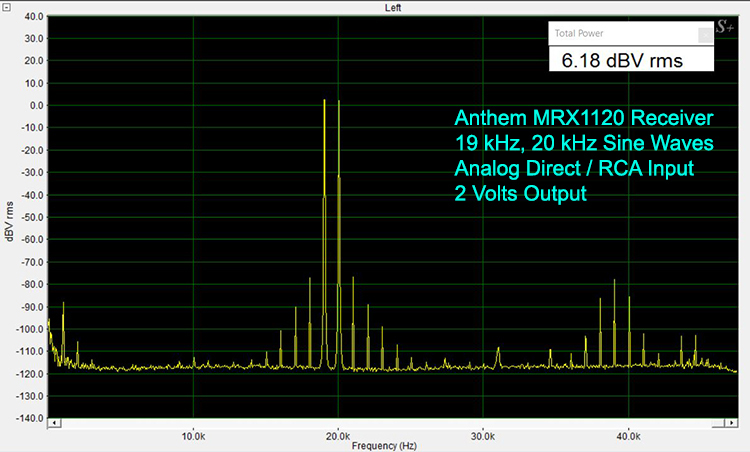
Here are the results for the 19 kHz, 20 kHz combined test frequencies using the RCA input. There is a visible B-A peak at 1 kHz about 88 dB below 2 VRMS. We see distortion spurs throughout the spectrum. The second harmonics at 38 kHz and 40 kHz are about 85 dB below 2 VRMS.
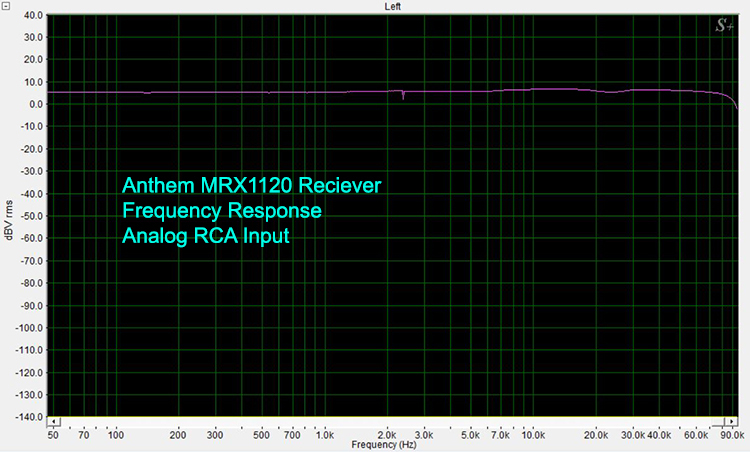
I measured the frequency response of the MRX 1120 out to 96 kHz. In analog direct, the response is flat out to about 70 kHz and then we see a gradual roll-off of the high frequencies at 80 kHz. Note that the minor “tick” at 2.5 kHz is an artifact from my measuring setup.
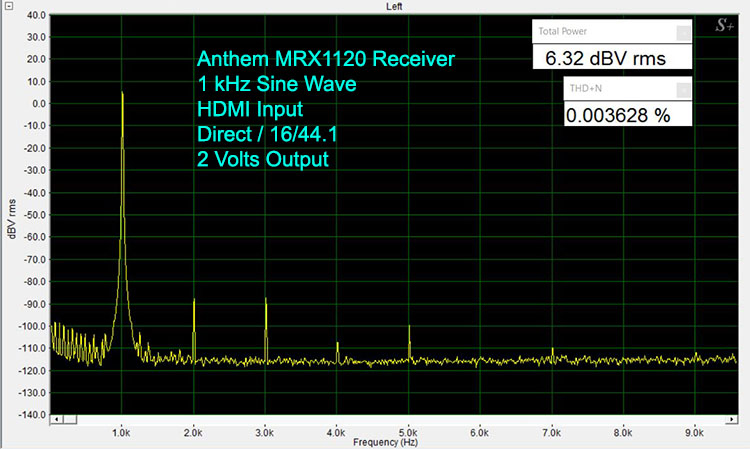
At 1 kHz, and 16-bit/44.1k sampling rate, THD+N was 0.003628% measured from the speaker outputs. We see several harmonics in the spectrum with the peak at 2 kHz being about 88 dB below 2 VRMS.
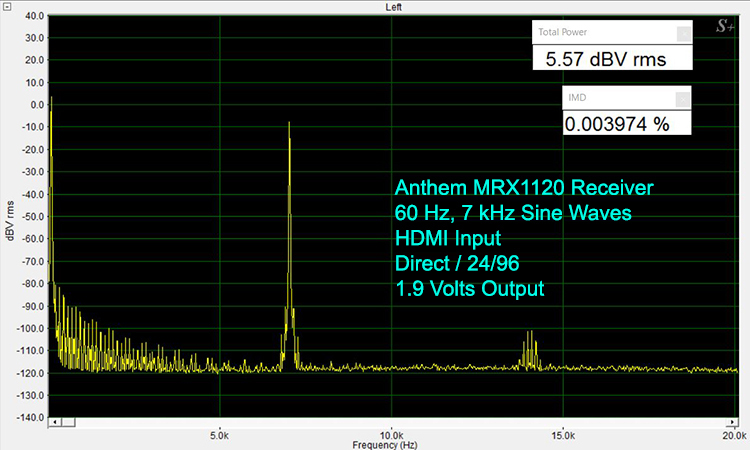
The IMD measurement using the HDMI input was 0.003974%. We see noise spurs on either side of the fundamentals and a second harmonic at 14 kHz at 100 dB below 1.9 VRMS.

Here are the results for the 19 kHz, 20 kHz combined test frequencies using the HDMI input with 24-bit/96k sampling at 2 VRMS. We see higher distortion spurs throughout the spectrum. There is a visible B-A peak at 1 kHz about 89 dB below each test tone which is insignificant. The second harmonics at 38 kHz and 40 kHz are about 85 dB below each test tone.
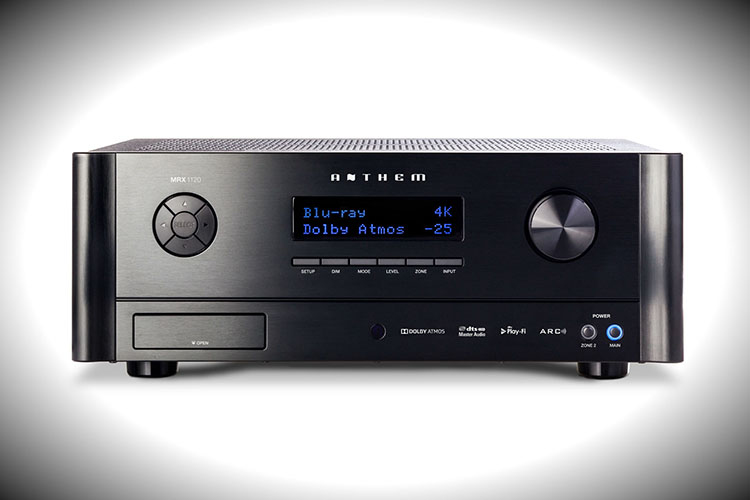
THE ANTHEM MRX 1120 is the Best Home Theater Receiver That I Have Had the Pleasure of Ever Using.
- Great design and solid construction.
- Lots of power with ample reserves.
- Superb sound quality for movies and music.
- ARC 2 room correction is a standout.
- Learning remote.
- Dolby ProLogic IIx for expanding stereo sources into surround.
- ARC subwoofer level set up stage.
To put not too fine a point on it, the Anthem MRX 1120 is the best home theater receiver that I have had the pleasure of ever using. It looks deceptively simple on the outside and while it might not have every last bell and whistle that some of its competitors do, the features it does have are the ones that matter and are well thought out. It’s defining characteristic though is its sound quality and the MRX 1120 is truly top shelf in this regard. I don’t think I’d be overstating it if I said that the sound quality you get from this unit is comparable to having separates from some other manufacturers. ARC 2 room correction continues to show why it is one of the most well regarded of these types of systems. Bass was always tight, powerful and perfectly rendered regardless of the source material. Also, as the first receiver that allowed me to experience a proper Atmos set up in my home, it was a home-run in terms of showing what the format can do, even with a slightly unorthodox speaker layout. If anything, it has unfortunately set the bar rather high for any other Atmos receiver that comes through these doors. Well done indeed!
*Note: As soon as Anthem releases an update enabling DTS:X functionality on this receiver, I will post a follow up report on my experience. Also, special thanks go out to Robert Kozel for his assistance with the bench test results.


